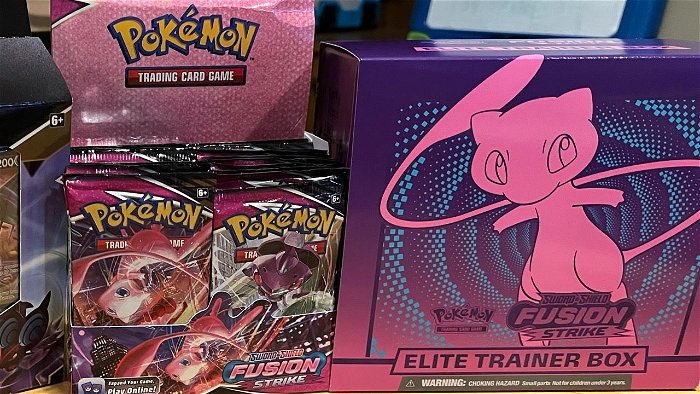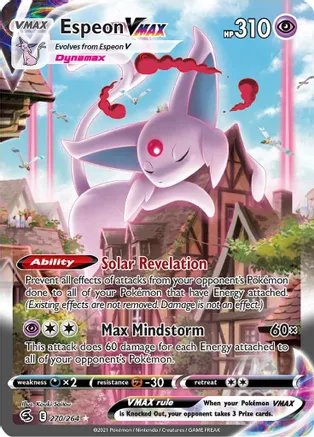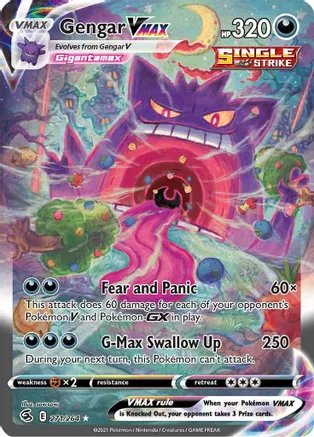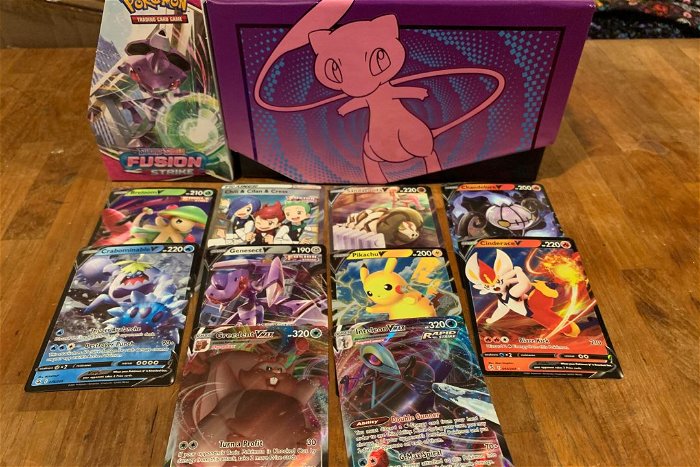The Pokémon Trading Card Game is extremely hot right now—and its latest set, Fusion Strike, demonstrates there’s a good reason for its popularity beyond the game’s anniversary.
Even if you aren’t up-to-date with the Pokémon Trading Card Game, you may have heard about its recent spike in popularity—inspiring Tickle Me Elmo-esque brawls in Target or Walmart aisles, and a scalping scene that, at its worst, could make PlayStation 5 resellers blush. There are a variety of reasons why it’s hard to find its products on store shelves, including supply chain issues, lockdown-induced boredom, influence from internet personalities like Logan Paul, the franchise’s much-hyped 25th anniversary, and the ever-present pull of nostalgia that keeps longtime fans around.
But as I realized while exploring the game’s latest set, Fusion Strike, it’s also because the game is so freaking good right now, for all manner of its consumers.

Fusion Strike is the 8th set under the Sword & Shield banner, which started in February 2020. While the eponymous Switch games have divided fans, their concepts have seen more success in cardboard form.
The Dynamax mechanic hit Switch players with a generally dull thud, but its tabletop equivalent, VMAX, has caught on in a big way. Likewise, the Rapid Strike and Single Strike mechanics were pulled from Sword and Shield’s Isle of Armor expansion pass, and the dual forms of the legendary Pokémon Urshifu. Additions like these impart some stimulating strategy while not sacrificing the game’s accessible, all-ages design.
Upon cracking into a booster box and Elite Trainer Box worth of Fusion Strike, I was immediately impressed with the deckbuilding possibilities presented by having all three Strike varieties and VMAX cards on the table. Single Strike Pokémon have powerful showstopper attacks, while Rapid Strike cards are more tactical. Fusion Strike splits the difference by checking for synergy between cards on your battlefield, like one Mew card’s ability to use attacks from other Fusion Strike cards on your Bench, or the Let’s All Rollout attack shared by a handful of spherical critters.
As a veteran Magic: The Gathering player and the parent of a young Pokémon fan, the prospects of these features are very exciting. They’re a great way to get younger or inexperienced players thinking of new mechanical combinations, a natural stepping stone toward more advanced play. Hopefully this approach continues into February’s set, Brilliant Stars.
The other thing I noticed as I opened Fusion Strike packs was the quality of the set’s art. Previous sets, especially before the Sword & Shield era, could be real mixed bags. Yet the art direction since last March’s Battle Styles has continued to trend upward, leading to the crowning one-two punch of Evolving Skies and Fusion Strike. Only two cards in the new set turned my lip up: the common Eevee, whose proportions look off after all the great art we got from its line last set; and Jynx, whose design is virtually irredeemable no matter how you slice it.
Full Art variants are the crowning jewel of recent sets, especially the Rainbow rares—though the overemphasis on the literally rainbow-themed variants still baffles me. Set mascot Mew gets two Rainbow Rare VMAX cards: one with minimalistic art and a rainbow filter, and one dynamic piece of art that shows it in true Dynamax form. The former is somewhat unremarkable and hard to distinguish from other cards in the same format when browsing your local shop’s cabinets or glancing across the playing field, while the latter conveys a full enormity that warrants its equally enormous resale value.
If there’s one spot where the Pokémon TCG’s design falters right now, it’s the hierarchy of rarity. Beyond the standard common-uncommon-rare paradigm typical for TCGs, Pokémon also differentiates between the different forms of rare cards—holo, ultra, holo V, and holo VMAX—and boasts two forms of “secret rare” cards whose collector numbers exceed the total number of cards in the set. But of these superfluous cards, most are actually dubbed “rainbow rares,” and they’re valued higher than the true “secret rare” cards.



If that stopped making sense to you halfway through the paragraph, welcome to the club.
Suffice it to say, this model undercuts the overall value of anything ranked “rare” in any form. I’ve noticed the same is true for Magic: The Gathering now. Its cards all fall into four rarities: common, uncommon, rare, and mythic rare. However there are also different variant styles for each set now, pushing all the other cards down a step on the rarity ladder and fanning the flames of the resale market.
Then again, Pokémon cards are still just fun for kids to open. My daughter couldn’t care less which cards were common, she just appreciated the art of familiar creatures, and was often as excited for standard energy cards as for special rares.

Regardless of the somewhat undecipherable rarity system, Fusion Strike also struck me with its well-chosen sampling of Pokémon. Each set is like a curated cross-section of the series’ total bestiary and its supporting cast across various mediums, depending on the set’s overall themes and setting. With the focus here on synergy and fusion, it’s fitting that the set’s roster adeptly pulls from all generations.
Galar is still the focus of the Sword & Shield era, but its stars share the spotlight. The Galarian starter trio gets VMAX cards, but the list of V cards contains both the mascot-tier Lucario and less likely candidates like Breloom and Dodrio. Mew is the cover model, but fellow mythical Pokémon are also featured like Celebi, Victini, Hoopa, and Genesect. More than ever, there’s probably something for just about every Pokémon fan in Fusion Strike.
The other current set, Celebrations, is similarly welcoming to most levels of Pokémon fans. As part of the series’ 25th anniversary, this smaller set is a collector’s dream. It consists of two 25-card sets: one a selection of different legendary ‘mons (and a handful of Pikachu, because reasons) updated for modern play; and the other a “Classic Collection” of recreated cards, given a special etching treatment.
There is one rub here, however—they come in 4-card boosters, typically only in expensive premium collections, alongside boosters of normal sets or other bonuses of questionable worth. It is still a trading card game, after all, and there’s a reason why Pokémon outranks Mickey Mouse as the most profitable franchise ever.
Nonetheless, between Fusion Strike, the rest of the Sword & Shield line, and Celebrations, this is a fantastic time to check out the Pokémon TCG. Players have fantastic options for deckbuilding, collectors have a smorgasbord of unicorns to chase, and even casual fans can find a welcoming environment to dip a toe into—if they can find any product on the shelves, that is.





